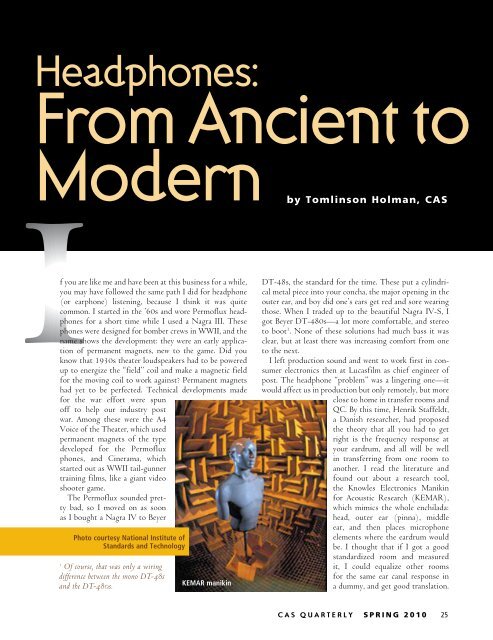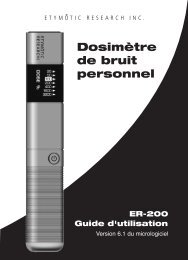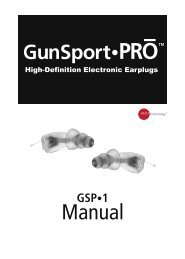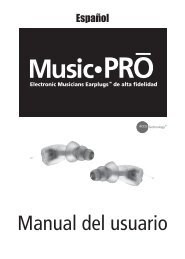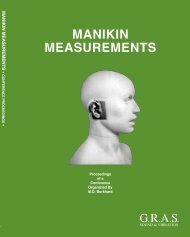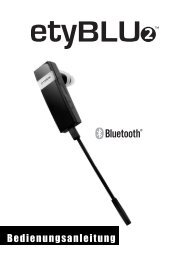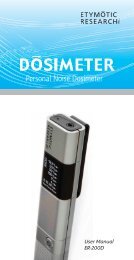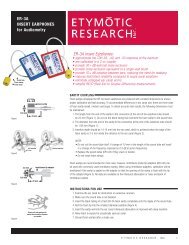Headphones: From Ancient to Modern - Etymotic Research
Headphones: From Ancient to Modern - Etymotic Research
Headphones: From Ancient to Modern - Etymotic Research
You also want an ePaper? Increase the reach of your titles
YUMPU automatically turns print PDFs into web optimized ePapers that Google loves.
<strong>Headphones</strong>:<br />
<strong>From</strong> <strong>Ancient</strong> <strong>to</strong><br />
<strong>Modern</strong><br />
f you are like me and have been at this business for a while,<br />
you may have followed the same path I did for headphone<br />
(or earphone) listening, because I think it was quite<br />
common. I started in the ’60s and wore Permoflux headphones<br />
for a short time while I used a Nagra III. These<br />
phones were designed for bomber crews in WWII, and the<br />
name shows the development: they were an early application<br />
of permanent magnets, new <strong>to</strong> the game. Did you<br />
know that 1930s theater loudspeakers had <strong>to</strong> be powered<br />
up <strong>to</strong> energize the “field” coil and make a magnetic field<br />
for the moving coil <strong>to</strong> work against? Permanent magnets<br />
had yet <strong>to</strong> be perfected. Technical developments made<br />
for the war effort were spun<br />
off <strong>to</strong> help our industry post<br />
war. Among these were the A4<br />
Voice of the Theater, which used<br />
permanent magnets of the type<br />
developed for the Permoflux<br />
phones, and Cinerama, which<br />
started out as WWII tail-gunner<br />
training films, like a giant video<br />
shooter game.<br />
The Permoflux sounded pretty<br />
bad, so I moved on as soon<br />
as I bought a Nagra IV <strong>to</strong> Beyer<br />
Pho<strong>to</strong> courtesy National Institute of<br />
Standards and Technology<br />
1 Of course, that was only a wiring<br />
difference between the mono DT-48s<br />
and the DT-480s.<br />
KEMAR manikin<br />
by Tomlinson Holman, CAS<br />
DT-48s, the standard for the time. These put a cylindrical<br />
metal piece in<strong>to</strong> your concha, the major opening in the<br />
outer ear, and boy did one’s ears get red and sore wearing<br />
those. When I traded up <strong>to</strong> the beautiful Nagra IV-S, I<br />
got Beyer DT-480s—a lot more comfortable, and stereo<br />
<strong>to</strong> boot 1 . None of these solutions had much bass it was<br />
clear, but at least there was increasing comfort from one<br />
<strong>to</strong> the next.<br />
I left production sound and went <strong>to</strong> work first in consumer<br />
electronics then at Lucasfilm as chief engineer of<br />
post. The headphone “problem” was a lingering one—it<br />
would affect us in production but only remotely, but more<br />
close <strong>to</strong> home in transfer rooms and<br />
QC. By this time, Henrik Staffeldt,<br />
a Danish researcher, had proposed<br />
the theory that all you had <strong>to</strong> get<br />
right is the frequency response at<br />
your eardrum, and all will be well<br />
in transferring from one room <strong>to</strong><br />
another. I read the literature and<br />
found out about a research <strong>to</strong>ol,<br />
the Knowles Electronics Manikin<br />
for Acoustic <strong>Research</strong> (KEMAR),<br />
which mimics the whole enchilada:<br />
head, outer ear (pinna), middle<br />
ear, and then places microphone<br />
elements where the eardrum would<br />
be. I thought that if I got a good<br />
standardized room and measured<br />
it, I could equalize other rooms<br />
for the same ear canal response in<br />
a dummy, and get good translation.<br />
CAS QUARTERLY SPRING 2010 25
Because of the THX efforts, I was able <strong>to</strong> buy a KEMAR and<br />
measure the frequency response of a properly-aligned dubbing<br />
stage sound system in its ear canal. I realized that this would<br />
also be useful for headphone listening, because if the reference<br />
is your eardrum, the frequency response should match there<br />
whether the sound field is external or from phones. I got a number<br />
of headphones and compared them <strong>to</strong> the dubbing stage<br />
response and found they were mostly off, significantly. This<br />
was some years ago, and Grant Imahara made the headphone<br />
measurements. Grant went on <strong>to</strong> reality television stardom—he<br />
plays himself on Discovery Channel’s MythBusters.<br />
Here’s what the Permoflux delivered compared <strong>to</strong> the<br />
“proper” response, which is the ear canal response measured on<br />
a dubbing stage aligned correctly <strong>to</strong> SMPTE 202.<br />
Permoflux<br />
And here’s the DT-48s<br />
Bey DT-48<br />
Not much better, but note that the scale has changed. Instead<br />
of -46 +4 dB of the Permoflux, now we’re -38 +5 dB. Yikes,<br />
these things are pretty bad, and yes they lack bass, a lot of bass.<br />
26 SPRING 2010 CAS QUARTERLY<br />
Here’s the next gen, a couple of AKG models, widely used in<br />
music studios:<br />
AKG K141<br />
AKG K240<br />
They measure -20 <strong>to</strong> +8 dB in one case, a distinct improvement,<br />
but an ear canal resonance around 2.5 kHz is strongly<br />
evident, and the lows are still not up <strong>to</strong> snuff.<br />
The film industry kind of moved on <strong>to</strong> settle, more or less,<br />
on the Sony MDR-7506 model. It measures thusly:<br />
Sony MDR<br />
While it still shows a strong ear canal resonance, the bass has<br />
been improved, and the response is -5 +10 dB, and we have<br />
moved a long ways from Permofluxes.<br />
Then, more recently, I discovered a company with a very<br />
familiar philosophy: earphones should be matched in response<br />
at your eardrum <strong>to</strong> the external sound field produced by a good<br />
sound system. They came at it from high-end consumer electronics<br />
and loudspeakers, not cinema, so I was interested <strong>to</strong> see<br />
how they’d match. A little surprisingly, they matched beyond<br />
my expectations. They are the <strong>Etymotic</strong> ER-4P model, and here<br />
is their response:
<strong>Etymotic</strong><br />
These show some roll off in the bass due <strong>to</strong> the degree of<br />
seal we were able <strong>to</strong> get <strong>to</strong> the (metal) ear canals of the dummy.<br />
I think on an actual ear and tightly coupled the bot<strong>to</strong>m end<br />
would be flat. And the response is a spectacular ±1 dB from<br />
mid-bass through a quite high frequency, above 12 kHz! Note<br />
graphically, we’ve gone from a 60 dB range <strong>to</strong> a 30 dB one, and<br />
in measurement from a 50 dB response range <strong>to</strong> a


